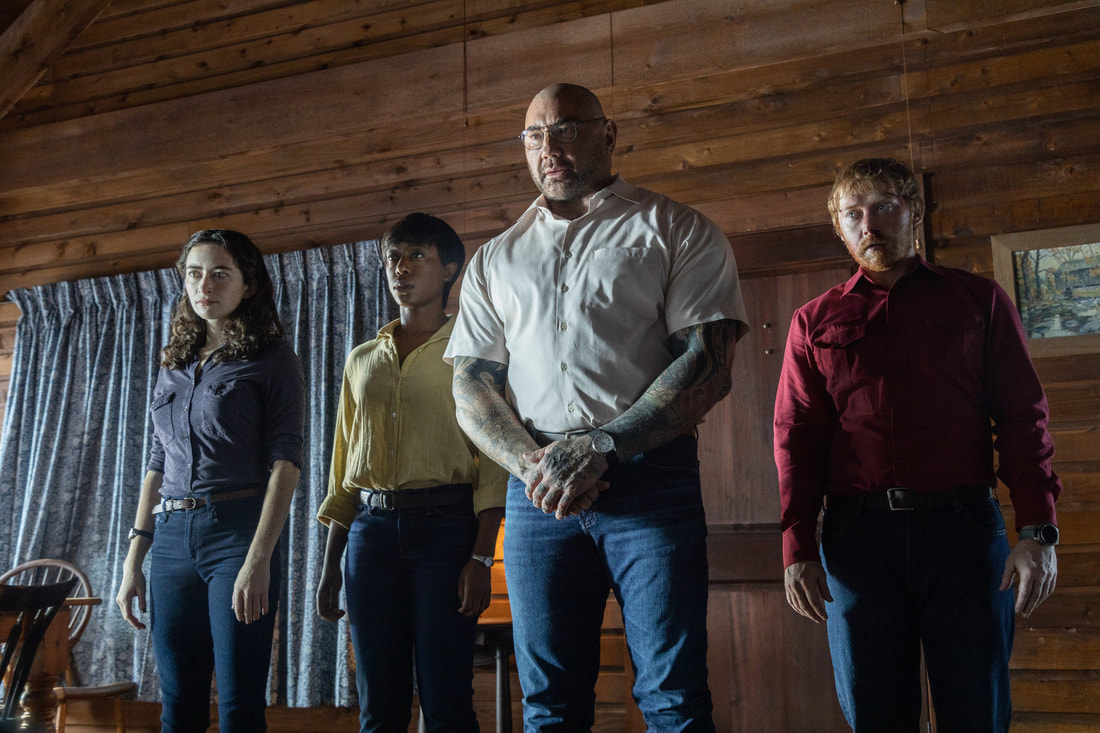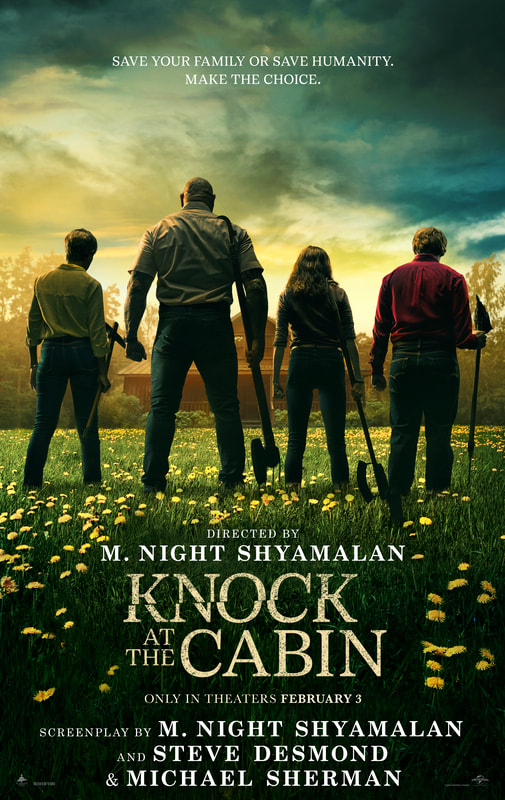Could You Make the Choice? M. Night Shyamalan Puts Certainty on Trial in KNOCK AT THE CABIN2/2/2023 If your expectations for Knock at the Cabin are based solely on M. Night Shyamalan’s previous film, Old (2021), those expectations probably aren’t high. Despite its fascinating concept, Old is stiff and awkward with unbalanced performances and an unrefined script. You might be tempted to make the same judgment about Knock at the Cabin after watching the first five minutes. The movie opens with stiff, over-rehearsed dialogue and awkward closeups that create an uneven tone and set a low bar for the rest of the movie. With vintage horror aesthetics in the opening credits and a creepy yet playful score, it’s difficult to tell whether or not Knock at the Cabin is taking itself seriously. But gradually, and then all at once, the tone becomes deadly serious. As the plot develops, it’s clear that Knock at the Cabin doesn’t suffer from the same problems as Old. M. Night Shyamalan’s latest film is a vicious, relentless mind game propelled by surprising and intense performances. With a script that gets exponentially better along the way, Knock at the Cabin far exceeds expectations. During that awkward opening scene, we’re introduced to a young girl, Wen (Kristen Cui), who’s on vacation in a woodland cabin with her dads, Eric (Jonathan Groff) and Andrew (Ben Aldridge). Wen is approached by a man named Leonard (Dave Bautista) who starts a very strange conversation with her. Just as Wen is starting to trust him, Leonard makes a very bizarre threat. Wen runs back inside the cabin and tries to warn her dads about the stranger, but Leonard isn’t far behind her. He makes his presence known with an eerie knock at the cabin door. He’s joined by three others — Sabrina (Nikki Amuka-Bird), Redmond (Rupert Grint), and Adriane (Abby Quinn) — who make up a very unlikely group of home invaders. What’s even more peculiar is that the group isn’t breaking into the cabin to steal valuables or kidnap Wen for ransom. They’re there to present Eric, Andrew, and Wen with a heartbreaking choice: to pick one member of their family to sacrifice in order to prevent the apocalypse. This scenario is, of course, completely absurd. But that’s what makes it the ideal setup for a thriller. Shyamalan puts the characters in such a strange and unlikely situation that the audience doesn’t know who to trust — and you won’t know whether to believe Leonard or not until the end of the movie. Has the innocent family really been chosen to stop the apocalypse by making a sacrifice, or are Leonard and his companions just psychotic? Knock at the Cabin creates a torturous sense of doubt and uncertainty that will keep your eyes glued to the screen until the very end. It puts our knowledge and certainties on trial, asking us to question how we know what we know. Knock at the Cabin is a delightfully crafted thriller that takes stylistic and aesthetic cues from classic horror and slasher movies. Shyamalan sure knows how to make an audience wince and squirm, even though most of the violence happens off-screen. It’s all about the buildup to violence – the sudden shouting, the fast-paced editing, the closeups, the anticipation of knowing that we might be about to watch a character get bludgeoned or skewered with fire poker. Shyamalan gets us to imagine vicious injuries without showing too much, although there’s enough oozing and spattered blood to maintain the slasher aesthetic. Despite its conventional horror/thriller style, Knock at the Cabin is no ordinary home-invasion story. It has one of those engaging plots that takes a while to figure out – and even when you do, you might not come to the same conclusion as the person sitting next to you. The four individuals who invade the cabin don’t act how you’d expect them to, and they don’t explain everything right away. These four characters are the last four people you’d put in a group together, and they’re certainly not your typical perpetrators. What makes them even more intriguing is that all four actors give extremely committed performances (although Grint’s American accent is inconsistent, and he can’t seem to figure out which region of the states his character is from). The ensemble goes all-in, and their performances will unnerve you. Bautista’s performance is especially memorable. He’s surprisingly serious and steady, creating a charming and mysterious character whose intentions aren’t clear until the end. A good thriller also needs good pacing, and Knock at the Cabin has just that. Once the story gets going, it doesn’t let up. The script, editing, and performances fit together perfectly, and the movie transitions between tense and tender scenes with ease. In between the violent bits of the movie, Shyamalan tells us Andrew and Eric’s love story. He paints a detailed picture of their backstory without spoon-feeding us information, making us care about the outcome of their ultimate decision. The implications of that decision, however, aren’t entirely clear. Knock at the Cabin is a tangled web of religious symbolism and social commentary, and it’s full of open-ended messages. It’s one of those movies that you’ll want to dissect, analyze, talk about, and rewatch. By making us doubt and question everything until the final moments of the film, Shyamalan invites us to question our own certainties and examine the ever-tightening echo-chamber we live in.
0 Comments
Leave a Reply. |
"Our embodied spectator, possibly perverse in her fantasies and diverse in her experience, possesses agency...finally, she must now be held accountable for it." Categories
All
|







